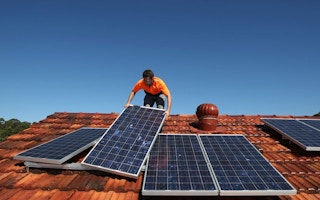Households across the country are putting solar panels on their roofs at a rate that has exceeded all expectations. This year we hit 1 million rooftops with photovoltaic (PV) solar panels, up from just 8,000 in 2007. This means that a staggering 2.6 million Australians, 11 per cent of the population, are now using the sun to power their homes.
The solar energy revolution is being led in suburbs and towns like Dubbo and Campbelltown in NSW, Bundaberg in Queensland, Hoppers Crossing in Melbourne, and Mandurah in Western Australia. This increase is being driven by ordinary Australians. It is the modest outer metropolitan suburbs across the country, with high concentrations of mortgages, which show the greatest uptake.
The cost of installing a PV panel today is less than a quarter of what it was in 2002. The decision to install solar panels is no longer just about global responsibility – it makes financial sense. As global momentum for solar continues to grow, the technology is advancing and manufacturing is being up-scaled in countries like China. Together these factors are rapidly driving down costs, making solar increasingly competitive even without subsidies. Businesses are watching the drop in technology costs keenly as payback periods become increasingly cost competitive.
Smart investors are realising that this trend is here to stay and that the future of energy is renewable. Just last week, AGL announced it is going ahead with a solar power station four times the size of Sydney CBD. This project is 15 times larger than any other solar power station in Australia and will become the largest in the Southern Hemisphere.
We are not alone in the move to solar energy. In fact, countries with far less sunshine are doing a lot more. Last year Australia’s total installed solar energy capacity amounted to less than eight per cent of Germany’s solar capacity.
Other countries are seeing what Germany has achieved and are determined to not be left behind. In 2012, China led the world in solar investment, pumping US$31.2 billion dollars into solar energy. Australia’s own investment of US$3.6 billion pales in comparison. As our largest trading partner, what matters to China, matters to Australia.
The momentum behind solar energy, both in Australia and around the world is unstoppable. The solar revolution is part of a bigger challenge, a challenge that is leading to the most sophisticated energy technologies as we combat climate change.
As extreme events continue to increase in frequency and intensity across the globe, people are realising the risk of doing nothing to stabilise our climate is too great. Australia is truly the lucky country as we are rich in the natural resources that will meet the challenges of the 21st century: renewable energy that harnesses the sun, wind and waves. Our future depends on renewable energy that will never run out (at least, not in the next 4 billion years) and that will provide safe, secure, long-term jobs and opportunities for Australians.
Tim Flannery is the Panasonic chair in Environmental Sustainability at Macquarie University and the chief commissioner at the Climate Commission. This article originally appeared here.

















